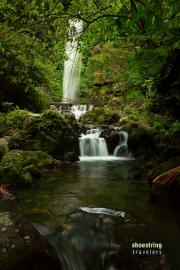
You may also check these:
https://shoestringtravelers.com/?q=node/62
People said this town was what Baguio City was more than 50 years ago, when the latter was a relatively laidback city of pines. Indeed one of the things I immediately noticed upon entering this quaint mountain town during a recent three-day stay was the refreshing scent of pine trees. A relatively small town, Sagada is surrounded by several stunning natural attractions: numerous karst formations on pine-covered hills, limestone caves with amazing underground formations, thundering waterfalls and hill peaks offering panoramic views of the verdant countryside. There is no shortage of man-made wonders as well: coffins hanging on precipitous limestone cliffs or sitting in clusters inside burial caves, hand-carved rice terraces around 2,000 years old and several examples of traditional art and architecture in town.
 The Bay-yo rice terraces near Bontoc as viewed from the highway to Sagada.
The Bay-yo rice terraces near Bontoc as viewed from the highway to Sagada.
The beautiful scenery does not even start in Sagada as we found out on our way to this mountain town from Banaue in Ifugao. The Halsema Highway that runs all the way to Benguet is probably the most scenic in the whole country. The section from Bay-yo to Bontoc and on to Sagada features spectacular views of pine forests covering the surrounding mountains, small waterfalls gushing down the hillsides and sometimes streaming on to the roadway, green and gold rice terraces and the surging Chico River with the occasional white water rafter.
Sagada's Attractions
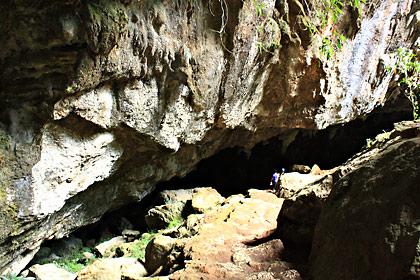 The mouth of Sumaguing Cave.
The mouth of Sumaguing Cave.
If nothing else you can just choose to stay in town and enjoy the cool mountain air and quiet pace of life but Sagada just has too many attractions to pass up. Among the most visited are the caves. The most popular is probably Sumaguing Cave located just south of Sagada town proper off the Suyo Road with its amazing limestone formations. The latter can be viewed via a steep descent through slippery and sometimes sharp rocks along the way. A guide is needed for this trek as he can help you navigate your way safely (more on the guides below). Guides also carry lanterns with them as the way down is dark. Be sure to wear comfortable clothing and to travel light on this trek.
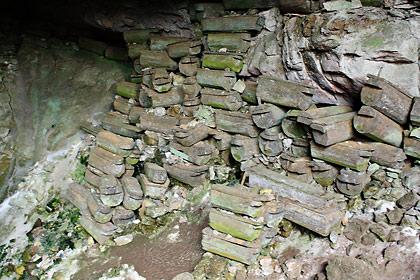 A collection of coffins at the entrance to Lumiang Cave.
A collection of coffins at the entrance to Lumiang Cave.
The 4-hour cave connection trek to Sumaguing Cave starts here via the
steep descent to the left of the stacks of coffins.
The Lumiang Burial Cave is located just a short distance north of Sumaguing Cave on the Suyo Road. We needed to do a short trek (passing through spectacular scenery of karst formations intermingled with clusters of pine trees on the hillsides) before reaching the entrance to the cave with its collection of coffins. If you’re the adventurer type you can do the 4 hour cave connection by descending through Lumiang Cave and exiting through Sumaguing. Again a guide is an absolute must for this adventure and you will need to go rappelling on some sections. We opted instead for the easier trek down Sumaguing Cave first, hopped aboard our rented vehicle for the 5-minute ride to Lumiang and trekked to the latter where we were able to view the stack of coffins without having to go inside the cave itself. Many of the coffins (the older ones) seem unusually short but we later learned that this was because the bodies were traditionally placed in a fetal position. Newer coffins have the bodies laid out in the more conventional way and are therefore longer.
Matangkib Cave near the Nangongogan Road just north of the town proper is even more accessible. We were eyeing it on one of the walks we did outside town but somehow we never got to visit the place.
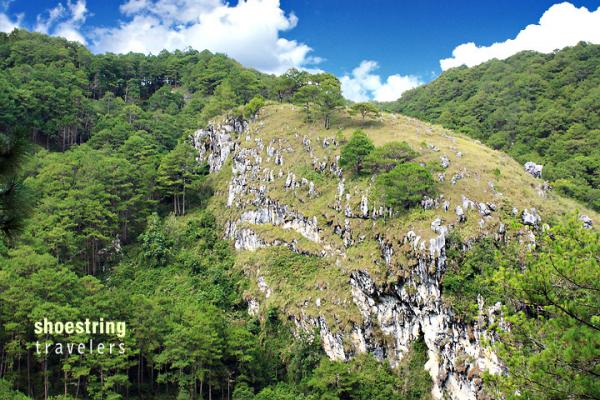 A common sight in Sagada is that of the numerous limestone or karst formations dotting the hillsides.
A common sight in Sagada is that of the numerous limestone or karst formations dotting the hillsides.
This also explains the presence of many underground caves in the region.
Numerous limestone or karst formations dot the Sagada countryside. Locals have used many of these as locations for hanging coffins; this is still being practiced today, albeit not as widespread as before and somewhat expensive. An example is the Sugong Hanging Coffins easily observed from a view deck by the Suyo Road on the way to the caves.
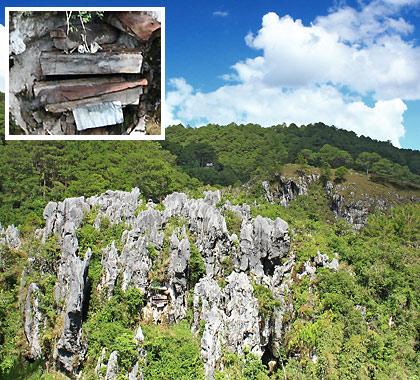 Sugong Hanging Coffins. Inset shows the coffins embedded in the
Sugong Hanging Coffins. Inset shows the coffins embedded in the
karst formation with a skull and bones on top of the uppermost coffin.
Echo Valley is another location for hanging coffins. Although we learned it was not necessary, we still decided to take a guide since it is easy to get lost here with its many pathways. To get to Echo Valley we passed by St. Mary’s Episcopalian Church – a landmark of Sagada – and through a public cemetery on a hillside. The path to the viewing site for the hanging coffins was narrow, had no guard rails and took us over a steep cliff. We learned some people have fallen off this path but one need not worry about this by simply exercising sound caution.
 St. Mary’s Church on the way to Echo Valley. Sagada’s population is predominantly
St. Mary’s Church on the way to Echo Valley. Sagada’s population is predominantly
Episcopalian, perhaps the only one of its kind in the country.
Sagada also has its share of rice terraces – not as spectacular as those in Ifugao (Batad, Banaue, Hapao and Bangaan among others) but still very beautiful. You can walk along several terraces such as those in Bangaan on the way to the Bomod-ok Falls or view them from a vantage point such as from Kiltepan and the Suyo road. We had an excellent view of a group of terraces near town from the top floor of George Guesthouse where we stayed.
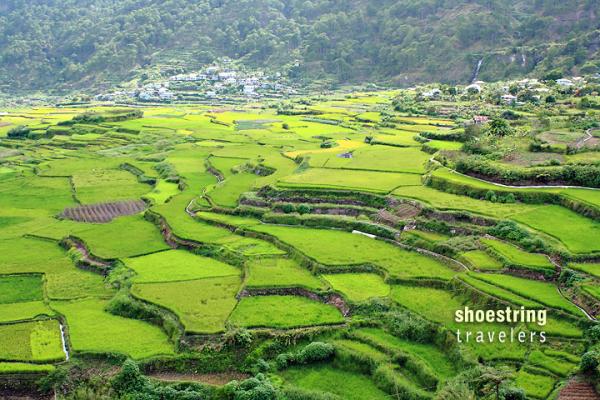 Rice terraces viewed from the Suyo Road on the way to Lumiang and Sumaguing caves.
Rice terraces viewed from the Suyo Road on the way to Lumiang and Sumaguing caves.
Sagada’s beautiful scenery makes strolling a pleasant activity here although, as a tour guide told us, there are no level paths in Sagada and you are either going uphill or downhill most of the time. It’s good to just take a walk around town. You won’t easily get lost because Sagada town proper is not a large place. The way to some scenic locations are not so conspicuous such as the pathway to Datil, where we passed by the backyards of local houses and the St. Joseph Resthouse on the way. After a few minutes the scenery just opens up and you are treated to a pleasant view of rice and vegetable fields back dropped by pine-tree blanketed hills. We did the same for some fields off the Nangongogan Road just north of the town center, trying to find the Bokong Falls on our own but failed to find it after a trek through the rice terraces there. (Other tourists hired guides for this trek but we felt it wasn’t worth the fee.)
Lake Danum, on the way to Besao (the next town after Sagada) may not be as picturesque as Sagada’s other attractions but is a good place for picnics. We arrived there late in the afternoon when the place was shrouded in fog and which gave it a mystical aura. Going back to town we got to pass bySagada Pottery where the pottery makers can explain their craft to you.
Some disappointments marred our otherwise enjoyable trip. We were supposed to go up Kiltepan, a hilltop from which one can get a spectacular sunrise view of the northern part of Sagada with its pine forests and rice terraces. I’ve seen a magnificent photo taken from Kiltepan’s vantage point with the sun rising over a cloud-shrouded valley so we couldn’t wait to get there. We agreed with a driver-guide to take us to Kiltepan on our first morning in Sagada. We were up and ready to go by 4:30AM but the guide didn’t show up. We got another guide for a second attempt the next day and he too didn’t show up. I ended up shooting the sunrise from the penthouse of our guesthouse instead:
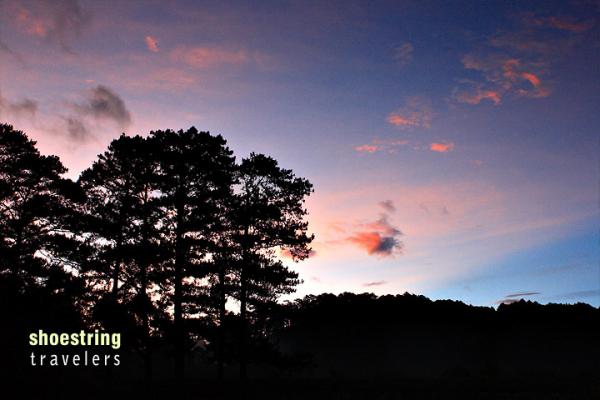
We also planned to do the hike to Bomod-ok Falls but were too tired from trekking by the second day. In retrospect we probably should have done this trek on the first day after arriving from Banaue. A newer attraction is the 7 Falls of Tap-ew including the stunning Pongas Falls which is farther out from town than most of the other attractions. I’ve heard that it is an even harder trek than the one to Bomod-ok.
Guests arriving at Sagada are encouraged to sign up at the municipal hall where there is an information office and tour guide association for visitors. This is not the only tour guides’ association in Sagada, however. Probably because of differences, a newer guides’ association was formed with its office located close to the Yoghurt House. There are almost no differences in rates however so there is little to choose from between the two. The only difference is that only the original guides’ association (located at the municipal hall) offers a guided tour to Bomod-ok Falls.
Accommodations and Dining
Before it became popular with the general public, Sagada was a backpacker’s secret. It was therefore not surprising that prices in town even today are not expensive. There is a wide range of accommodations to choose from but most cost only about P200 to P300 per person per day. Most are located an easy walk from the town center. We chose George’s Guesthouse, a newer place with a double room for our group (2 beds per room) that cost us P250 per person and came with a hot shower bathroom, cable TV and free wi-fi access. We later learned that it normally costs P300 per person but somehow we ended up paying less. Most guesthouses are clean and many have great views over town.
 A sandwich at Bana’s Café and Restaurant. It’s probably the best coffee place in town and they
A sandwich at Bana’s Café and Restaurant. It’s probably the best coffee place in town and they
also serve the famous civet cat coffee (locally known as café alamid).
Food is reasonably priced in Sagada. Most meals will cost around P130 each but of course there are far cheaper rates. The servings are generous for the most part, especially with the vegetables. There’s not a lot of fancy meals being served but the food is great and the places are cozy.
Yoghurt House is a popular dining place a short walk downhill from the town center. We were pleasantly surprised to find out that it serves more than yoghurt dishes. I thought their pasta was excellent and they have many vegetarian dishes to choose from. They also have a veranda where one can dine and enjoy the scenery around town. Bana’s Café and Restaurant is one of the few places that (surprisingly) serves a variety of brewed coffee including the famous civet cat variety. We thought their sandwiches and breakfast meals were very good and they have a good view of the area near St. Mary’s Church. Most of the inns around town have their own restaurant.Masferre County Inn near the Yoghurt House has a large restaurant that serves familiar but tasty dishes. They also have an excellent collection of Eduardo Masferre’s reproduced black and white photographs of the Cordilleras and its people in the mid-20th century. The one we’d recommend would be Ganduyan Inn (they only serve breakfast food the whole day).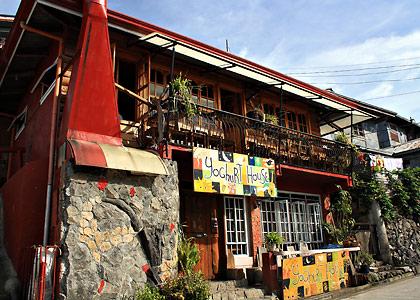 Yoghurt House: it’s more than just yoghurt.
Yoghurt House: it’s more than just yoghurt.
Getting There
There are two ways to get to Sagada from Manila. One is via Baguio and the other through Banaue. If you go by car you can drive all the way through either one of these routes. It’s best to take an SUV or some other vehicle that can take some of the rough stretches of road on the way. There’s not a lot of the latter in recent years as much of the Halsema Highway on either route is now concreted but there are still some sections that have been hit by landslides during the typhoon months and have yet to be fully repaired. The road just before Sagada is also still unpaved (though graded) and driving there during the rainy season could be tricky.
If you go by public vehicle, as we did, here’s what you can do:
Via Baguio: Take a bus to Baguio. For P250 more you can take Victory’s Deluxe buses (with onboard toilet) and save time. Otherwise the trip usually takes 6 hours on the regular aircon buses. From Baguio take the GL Liner to Sagada. The first GL bus leaves around 6AM. Make sure you arrive in Baguio by lunchtime at most since the last GL bus leaves for Sagada at 1PM. These are non-aircon buses but since you will be traveling on a road system with the highest altitude in the Philippines you will hardly need air conditioning. Going back to Baguio from Sagada you can take the early morning GL bus. Again the last bus leaves for Baguio at 1PM. Total travel time from Baguio to Sagada is around 6 hours. The Halsema Highway offers fantastic views so try to take the right side of the bus when going to Sagada from Baguio.
Via Banaue: We took this route as we have been to Banaue before although in retrospect we probably should have tried the Baguio route for a change of scenery. The only bus now going direct to Banaue is Ohayami Trans (no it is not a Japanese-owned bus; they only inverted the name of the owner – Mr. Imayaho) with buses leaving for Banaue from their terminal at the corner of Fajardo and Lacson streets in Sampaloc. Buses leave at 9 and 9:45 PM every day. Apparently there is more than one bus leaving at the same hour. The trip normally takes 8 to 9 hours but with portions of the Maharlika Highway being repaired in Nueve Ecija and on the Dalton Pass our return trip actually took 10.5 hours.
In Banaue the most convenient would be to take a van straight to Sagada. The price for a van normally costs P3000 to as much as P4000 so it is best to travel in a large group or to go with other tourists bound for Sagada. A van will get you to Sagada in less than 3 hours. The other option is to take a jeepney in Banaue for Bontoc and from Bontoc to take another ride to Sagada. The two rides will usually take a total of 3 hours but the jeepneys will not leave unless they are full (which includes filling the space on top of the roof). Some friends said they took 5 hours to make this trip because of the extra time spent waiting for the jeepneys to fill up with passengers. The last jeep in Bontoc leaves for Sagada at 1 PM. The fantastic scenery along the way will make you forget any inconvenience you might have in making this trip.





